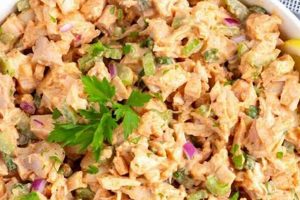This dish represents a fusion of two popular salad formats: the classic Caesar salad and pasta salad. It typically incorporates grilled or roasted chicken breast, romaine lettuce, croutons, Parmesan cheese, and a creamy Caesar dressing, combined with cooked pasta (often rotini, farfalle, or penne). Variations may include other vegetables like cherry tomatoes, bell peppers, or cucumbers.
Combining the heartiness of pasta with the refreshing elements of a Caesar salad creates a complete and satisfying meal. This adaptable dish can be served as a light lunch, a side dish at a barbecue, or a potluck contribution. Its customizable nature allows for adjustments to ingredients and dressing based on dietary needs and preferences, making it a versatile option for diverse palates. The historical evolution reflects broader culinary trends of incorporating pasta into various salad formats for added substance and texture.
Further exploration will cover ingredient selection, preparation techniques, variations for different dietary restrictions, and tips for achieving optimal flavor and presentation.
Tips for an Exceptional Pasta Caesar Salad
Achieving a well-balanced and flavorful pasta Caesar salad requires attention to several key elements. The following tips offer guidance on ingredient selection, preparation methods, and serving suggestions.
Tip 1: Pasta Selection: Opt for short, sturdy pasta shapes that hold the dressing well, such as rotini, farfalle, or penne. Avoid long, thin noodles like spaghetti or linguine, which can become tangled and difficult to manage.
Tip 2: Chicken Preparation: Grilled or roasted chicken provides optimal flavor. Ensure the chicken is cooked thoroughly and cooled before adding it to the salad to prevent wilting the lettuce.
Tip 3: Romaine Crispness: Wash and thoroughly dry romaine lettuce leaves before assembling the salad. Consider chilling the lettuce to enhance crispness.
Tip 4: Crouton Quality: Homemade croutons offer superior flavor and texture. Cube day-old bread, toss with olive oil and seasonings, and bake until golden brown.
Tip 5: Dressing Considerations: Use high-quality Caesar dressing. Alternatively, prepare a homemade dressing for maximum flavor control. Add the dressing just before serving to prevent the salad from becoming soggy.
Tip 6: Ingredient Incorporation: Gently toss all ingredients together to ensure even distribution of the dressing and prevent damage to the lettuce.
Tip 7: Parmesan Enhancement: Freshly grated Parmesan cheese offers a richer flavor than pre-grated varieties.
By following these guidelines, one can create a pasta Caesar salad that delivers a harmonious blend of flavors and textures. Attention to detail in each step contributes to a superior culinary experience.
Following these preparatory steps ensures a flavorful and satisfying culinary experience. The subsequent section will conclude this exploration.
1. Grilled Chicken
Grilled chicken plays a pivotal role in a chicken Caesar pasta salad recipe, contributing significantly to its flavor profile and overall appeal. The grilling process imparts a smoky char and enhances the inherent savory notes of the chicken, creating a desirable contrast to the other ingredients. This contrasts with other preparation methods like boiling or frying, which might result in a blander or greasier outcome, respectively. Specifically, the Maillard reaction, a chemical process occurring during grilling, creates hundreds of flavor compounds, adding depth and complexity. The high heat of grilling also renders excess fat, resulting in a leaner protein source within the salad.
The choice of marinade or dry rub further influences the final flavor profile of the grilled chicken. A simple lemon-herb marinade can provide a bright, citrusy counterpoint to the richness of the Caesar dressing, while a smoky paprika rub can amplify the charred notes. For instance, a Mediterranean-inspired marinade with oregano, garlic, and lemon zest complements the creamy dressing and fresh romaine. In contrast, a Southwestern-style dry rub with chili powder and cumin can add a spicy kick. These variations demonstrate the versatility of grilled chicken within this recipe.
Successfully integrating grilled chicken involves achieving proper doneness while retaining moisture. Overcooking results in dry, tough meat, detracting from the salad’s overall quality. Employing a meat thermometer ensures accurate cooking, aiming for an internal temperature of 165F (74C). Resting the cooked chicken allows the juices to redistribute, resulting in a more tender and flavorful final product. Careful consideration of these factors optimizes the contribution of grilled chicken to the chicken Caesar pasta salad.
2. Crisp Romaine
Crisp romaine lettuce provides a foundational textural element in a chicken Caesar pasta salad recipe, offering a refreshing counterpoint to the richness of the dressing and other ingredients. Its structural integrity and slightly bitter flavor contribute significantly to the overall sensory experience.
- Textural Contrast:
The crispness of romaine offers a satisfying contrast to the soft pasta and creamy dressing. This textural diversity elevates the salad beyond a homogenous mixture, providing a more dynamic eating experience. Consider the difference between biting into a crisp romaine leaf versus a wilted one; the former provides a refreshing snap, while the latter contributes an unpleasant sogginess.
- Flavor Balance:
Romaine’s subtle bitterness balances the richness of the Caesar dressing and the savory notes of the chicken. This interplay of flavors prevents the salad from becoming overly rich or one-dimensional. For example, the slight bitterness of romaine complements the salty, umami flavors of Parmesan cheese and anchovies often found in Caesar dressings.
- Structural Integrity:
Sturdy romaine leaves hold up well to the dressing and other ingredients, maintaining their shape and texture even after being tossed. This structural integrity ensures that the salad remains visually appealing and enjoyable to eat. In contrast, more delicate greens like butter lettuce would quickly wilt and become soggy.
- Nutritional Value:
Romaine lettuce contributes vitamins and minerals, adding nutritional value to the salad. This nutritional aspect enhances the dish’s appeal as a healthy and satisfying meal option. Romaine is a good source of Vitamin A and Vitamin K, contributing to overall dietary balance.
The interplay of these facetstextural contrast, flavor balance, structural integrity, and nutritional valueestablishes crisp romaine as an essential component of a successful chicken Caesar pasta salad. Its presence elevates the dish from a simple combination of ingredients to a well-balanced and enjoyable culinary creation. The crispness, in particular, invigorates the palate and enhances the overall dining experience.
3. Creamy Caesar Dressing
Creamy Caesar dressing forms an integral part of the chicken Caesar pasta salad recipe, acting as a unifying element that binds the diverse components and contributes significantly to the overall flavor profile. Its creamy texture coats the pasta and other ingredients, ensuring even distribution of flavor and enhancing the salad’s palatability. The dressing’s characteristic tangy, savory flavor, derived from ingredients like garlic, lemon juice, Parmesan cheese, and Worcestershire sauce, complements the other elements, creating a harmonious balance. For instance, the dressing’s acidity cuts through the richness of the chicken and the creaminess of the Parmesan, preventing the salad from feeling heavy. Conversely, a vinaigrette-based dressing would lack the necessary richness to coat the pasta effectively and might result in a less cohesive final product. The emulsion of oil and egg yolk in traditional Caesar dressings contributes to a rich mouthfeel, further enhancing the sensory experience. This creamy texture also helps prevent the salad from drying out, maintaining its freshness for longer periods.
Variations in Caesar dressing recipes offer opportunities for customization and cater to individual preferences. The addition of anchovies, a traditional ingredient, introduces a deeper umami flavor, while roasted garlic can impart a mellow sweetness. Dietary adjustments, such as using vegan mayonnaise or omitting the anchovies, allow for greater inclusivity. For example, using a cashew-based cream instead of egg yolks allows individuals with egg allergies to enjoy the dish without compromising flavor or texture. The flexibility of Caesar dressing recipes reflects its adaptability within the broader culinary landscape.
Understanding the role of creamy Caesar dressing within this specific recipe context highlights its impact on the final product. Balancing the dressing’s richness with the other ingredients is crucial for achieving a harmonious flavor profile. Proper emulsification ensures the dressing’s stability and prevents separation, leading to a more visually appealing and texturally satisfying salad. Consideration of these factors contributes significantly to a successful and enjoyable culinary outcome. Mastery of these elements enhances the overall dining experience, highlighting the significant influence of creamy Caesar dressing on the chicken Caesar pasta salad recipe.
4. Pasta Choice
Pasta selection significantly influences the overall success of a chicken Caesar salad pasta salad recipe. The chosen pasta shape affects not only the dish’s aesthetics but also its ability to hold the dressing, its ease of consumption, and the overall textural experience.
- Shape and Structure:
Short, sturdy pasta shapes, such as rotini, farfalle, and penne, are generally preferred. Their compact structure and ridges effectively capture the creamy Caesar dressing, ensuring each bite delivers a balanced flavor profile. Conversely, long, thin pasta like spaghetti or linguine tends to clump together, making it challenging to eat and less effective at holding the dressing. Consider the visual contrast between a salad with evenly coated rotini and one with clumps of spaghetti; the former presents a more appealing and palatable dish.
- Cooking Method and Texture:
Properly cooked pasta is crucial. Overcooked pasta becomes mushy and loses its structural integrity, detracting from the salad’s texture. Al dente pasta, cooked until firm to the bite, provides the desired chewiness and contributes to a more satisfying eating experience. The difference between al dente and overcooked pasta is palpable; the former offers a pleasant resistance, while the latter disintegrates upon contact.
- Size and Proportion:
The pasta’s size should be proportionate to the other ingredients. Overly large pasta pieces can overwhelm the salad, while excessively small pieces might get lost among the other components. Visualize a salad with large radiatore pasta versus small ditalini; the former dominates the dish, while the latter becomes almost invisible. Balance is key to creating a harmonious composition.
- Flavor Absorption:
While pasta itself has a neutral flavor, it readily absorbs the flavors of the dressing and other ingredients. This absorption contributes to the overall cohesion of the dish. The pasta acts as a flavor carrier, ensuring that each bite is infused with the essence of the Caesar dressing and other components. Imagine the difference between plain pasta and pasta coated in a flavorful dressing; the latter delivers a more complex and satisfying taste.
Careful consideration of these factorsshape and structure, cooking method and texture, size and proportion, and flavor absorptiondemonstrates the integral role pasta choice plays in the overall success of the chicken Caesar pasta salad recipe. A well-chosen pasta complements the other ingredients, enhancing both the visual appeal and the sensory experience of the dish. The selection ultimately impacts the balance of flavors, textures, and ease of enjoyment, contributing to a more satisfying culinary outcome.
5. Fresh Parmesan
Fresh Parmesan cheese plays a crucial role in a chicken Caesar pasta salad recipe, contributing significantly to its flavor profile and overall quality. Unlike pre-grated Parmesan, which often contains cellulose fillers that hinder its ability to melt and bind with other ingredients, fresh Parmesan offers a superior texture and a more pronounced, nuanced flavor. The absence of additives allows the natural sharpness and saltiness of the cheese to shine through, enhancing the other components of the salad. For instance, when freshly grated Parmesan comes into contact with the creamy Caesar dressing, it melts slightly, creating a richer, more cohesive coating on the pasta and other ingredients. This melting action also releases aromatic compounds, intensifying the sensory experience. In contrast, pre-grated Parmesan tends to remain powdery and separate from the other elements, diminishing its impact on the overall flavor and texture of the salad.
The choice between fresh and pre-grated Parmesan directly impacts the perceived quality of the dish. Freshly grated Parmesan contributes a complex umami flavor, derived from its aging process, that complements the savory notes of the chicken and the tanginess of the Caesar dressing. This depth of flavor elevates the salad beyond a simple combination of ingredients, creating a more sophisticated and satisfying culinary experience. Moreover, the slightly granular texture of freshly grated Parmesan adds a pleasant dimension to the salad’s mouthfeel, contrasting with the smoothness of the dressing and the crispness of the romaine lettuce. Consider the difference between a salad topped with finely grated fresh Parmesan and one with powdery pre-grated cheese; the former offers a more refined texture and a more intense, lingering flavor.
Utilizing fresh Parmesan underscores a commitment to quality and enhances the overall enjoyment of the chicken Caesar pasta salad. This seemingly small detail can significantly impact the final product, demonstrating the importance of ingredient selection in achieving culinary excellence. The distinction between fresh and pre-grated Parmesan, while subtle, contributes significantly to the overall sensory experience, highlighting the value of prioritizing quality ingredients in even seemingly simple dishes. This attention to detail ultimately elevates the dish, transforming it from a basic pasta salad into a more refined and flavorful culinary creation.
Frequently Asked Questions
This section addresses common inquiries regarding the preparation and variations of chicken Caesar pasta salad.
Question 1: Can different types of lettuce be used?
While romaine is traditional, other lettuces like butter lettuce or green leaf lettuce can be substituted. However, these may have a different texture and flavor profile, impacting the overall experience. Romaine’s sturdiness is preferred for its ability to hold up to the dressing and other ingredients.
Question 2: What are suitable alternatives to grilled chicken?
Roasted, baked, or pan-fried chicken can be used. Pre-cooked rotisserie chicken offers a convenient option. These alternatives offer varying flavor profiles and textures compared to grilled chicken. Consider how the chosen cooking method might complement or contrast with the other ingredients.
Question 3: How can the recipe be adapted for vegetarian diets?
Omitting the chicken creates a vegetarian version. Adding chickpeas, white beans, or tofu can provide additional protein and texture. These additions introduce different nutritional profiles and flavor nuances.
Question 4: Can the dressing be made in advance?
Caesar dressing can be prepared a day or two in advance and stored in an airtight container in the refrigerator. Emulsified dressings might separate over time and may require whisking before serving. The flavor profile may also intensify over time.
Question 5: How long can the salad be stored?
The salad is best consumed within a few hours of preparation to maintain optimal texture and flavor. Storing the salad, especially with the dressing already added, can lead to the lettuce wilting and the pasta becoming soggy. If storing is necessary, keep the dressing separate and add it just before serving.
Question 6: How can the nutritional value be increased?
Adding other vegetables, such as bell peppers, cucumbers, or cherry tomatoes, enhances the salad’s nutritional content and adds textural variety. Consider the nutritional profile of each addition and its impact on the overall flavor balance.
Addressing these frequently asked questions provides a more comprehensive understanding of the recipe’s versatility and adaptability. Informed choices regarding ingredients and preparation methods empower individuals to customize the dish to their preferences and dietary needs.
The following section will offer concluding thoughts and recipe variations.
Chicken Caesar Salad Pasta Salad Recipe
This exploration has provided a comprehensive overview of the chicken Caesar salad pasta salad recipe, highlighting the crucial role of each component in contributing to the dish’s overall success. From the smoky char of the grilled chicken to the crisp freshness of the romaine lettuce, the tangy richness of the Caesar dressing, the structural integrity of the pasta, and the sharp bite of fresh Parmesan, each element plays a vital role in creating a harmonious balance of flavors and textures. Careful consideration of ingredient selection, preparation methods, and potential variations allows for a customized culinary experience tailored to individual preferences and dietary needs. Understanding the interplay of these elements empowers informed decision-making, ensuring a consistently satisfying and enjoyable outcome.
The adaptability of this recipe reflects its potential within diverse culinary contexts. Whether served as a light lunch, a side dish at a barbecue, or a potluck contribution, the chicken Caesar salad pasta salad recipe offers a versatile and satisfying option. Continued exploration of flavor combinations and ingredient variations promises further culinary innovation, ensuring this dish remains a timeless classic, adaptable to evolving palates and culinary trends.






